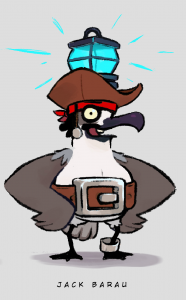The 2016-2017 season: Assessment of field actions regarding the monitoring of the Barau Petrel’s colonies.
News publié le 3 Dec 2017To save a species, one must know it. Each breeding season of the Barau petrel, the LIFE+ Pétrel team and its partners work on understanding this species, whether on the field, in the laboratory or at the office.
300: This is the number of days that were spent on field missions by the LIFE+ Pétrel agents in 2016. This being 42 days more than in 2015. The missions are divided between the gathering of information on the Barau Petrel, the search for the Mascarene petrel, the control of invasive alien species, chumming, etc…
But what do the field agents do regarding the understanding of the species?
Play with “Jack Barau”, the famous Petrel pirate !
Actualités publié le 4 Jul 2017Synopsis
After a few months at seas, the famous pirate Jack Barau has come back on his native island : Petrels Island.
Like every year, his vessel moored in Port Royal Bourbon awaits young petrels. They are eager to meet up with him since he’ll guide them through their maiden flight across the ocean.
But upon Jack’s arrival, the young petrels are held captive by ruthless beasts.
The fearsome bunch of rat pirates and cat soldiers, equipped with their incandescent lanterns, keep watch on the island.
Beware of the fledgeling for they must not fall into their grasp!
Why is this wondrous island so perilous? Would it be a scheme devised by his brother in arms, Black Bourbon?
After 130 years of mystery, a breeding colony of Mascarene Petrel has finally been discovered!
Actualités publié le 20 Jan 2017On November 15, 2016, at 11:36 AM, after more than 15 years of research carried out by an international group of ornithologists, the LIFE+Petrels project team in Reunion island successfully discovered the first breeding burrows of the Mascarene Petrel (Pseudobulweria aterrima), a species considered to be one of the 15th rarest and most threatened species in the world. This petrel, which is endemic to Reunion Island, is listed as Critically Endangered by the IUCN but the lack of knowledge on its breeding ecology has to date prevented the implementation of effective conservation actions. Thus, the discovery of this first breeding colony is a major step towards developing better conservation strategies for the protection of the species and for the preservation of the world’s natural heritage in general.




